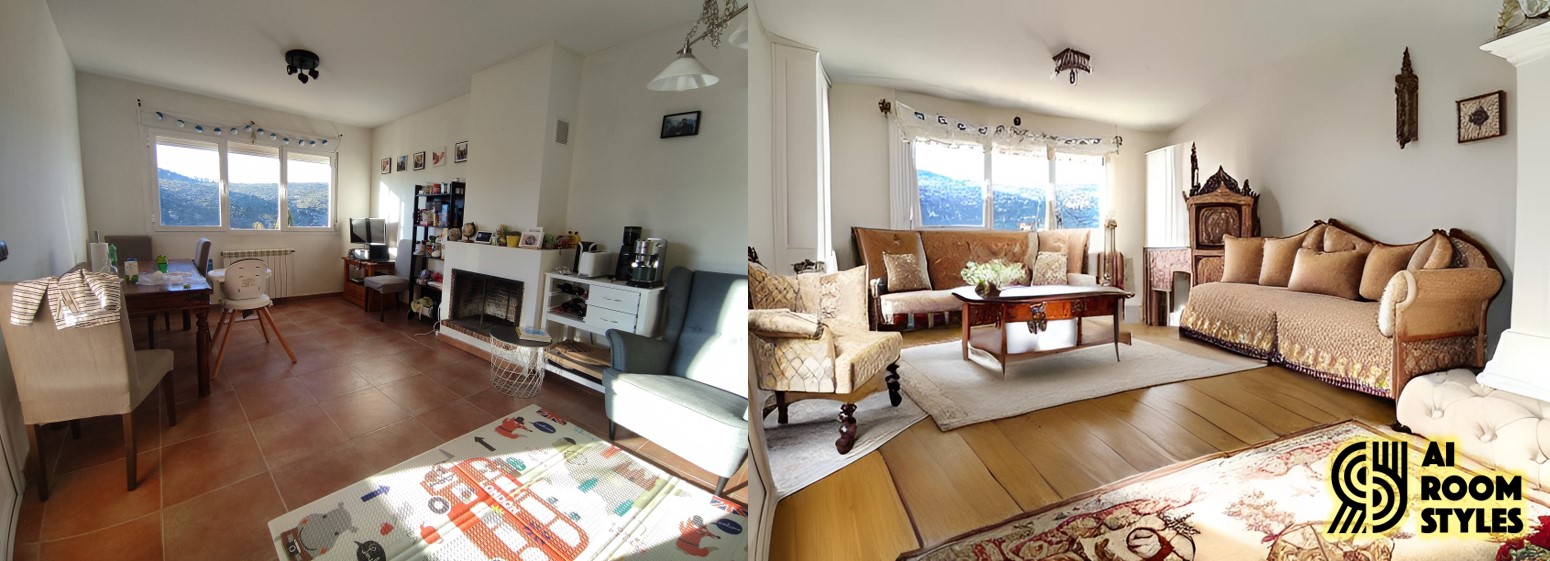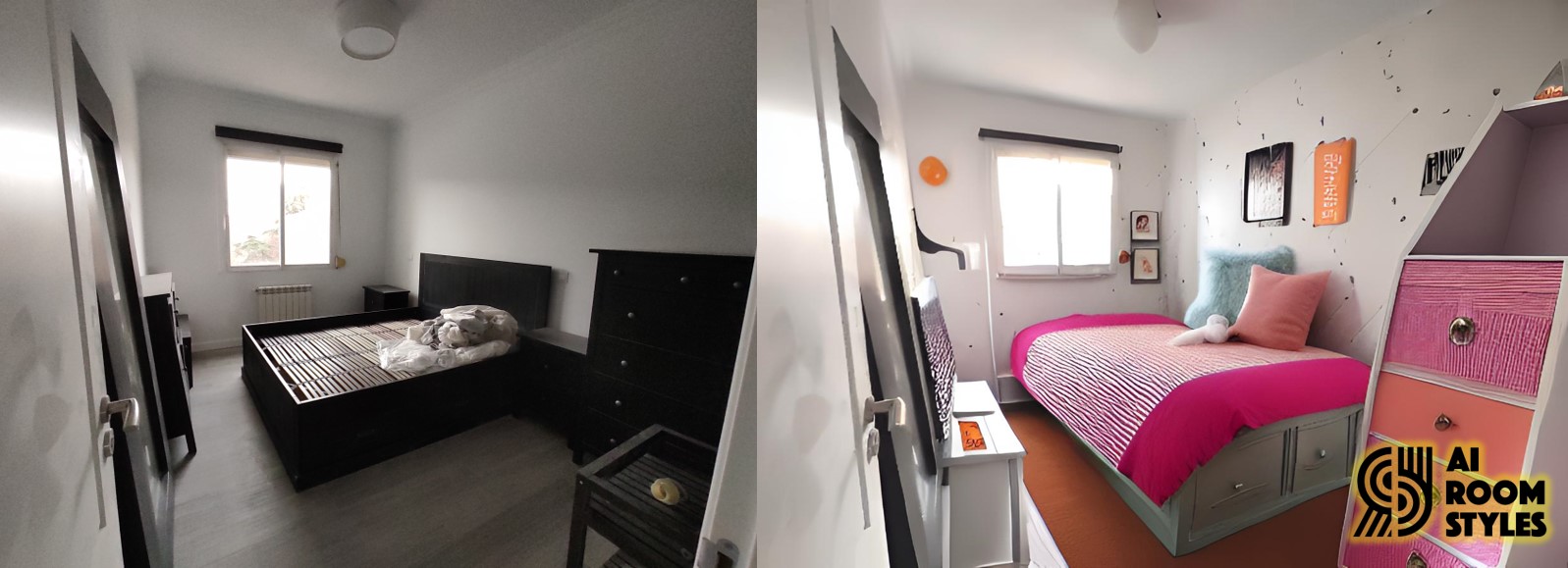Interior Design Origins and Evolution
2024/08/08, by Maria-Victoria Galli

Generated art for interior design evolution.
This article delves into different historical trends up to the present day, highlighting key styles and characteristics that have shaped our living spaces. I illustrate how I see Interior Design in the future as we live in an ever-changing environment.
Historical Context: Location and Human Being Needs
In Western countries, architecture specialists agree that interior design originated in Egypt, Greece, and Rome. On the other hand, late discoveries categorized interior design as a catalyst for political conceptions, winning the battle for how men should live.
History in Interior Design is a big topic explored by contemporaneous architects. On the Indian continent, for example, Interior Design goes further in history than on other continents, even if it was discovered not so long ago.
Among the authors who explore the “history of interior design,” there seems to be consensus about what influences this industry the most in Western countries. For some, that is the geographical location and the needs of human beings in general. Thus, interiors reflect different things among cultures and places: societal changes, technology, and artistic movements.
For example, interiors reflected social status and moral values during the Victorian times.
Therefore, where, how, and in what style of furnishing people lived was closely connected to the question of what kind of society was to be (re)constructed. According to Jane C. Loeffler, in her book: “the architecture of diplomacy”
Chronological Legacy
We travel in time to provide a more comprehensive foundation for understanding the industry's roots. The concept of interior design has existed since humans first created shelters, but it became more sophisticated with the rise of early civilizations. Here is a more detailed look at some key ancient cultures:
1. Mesopotamia (c. 3500 BCE - 539 BCE):- One of the earliest civilizations to show evidence of intentional interior design.
- Homes were built around central courtyards for light and ventilation.
- Walls were often decorated with painted murals or carved reliefs.
- Furniture was functional, including beds, chairs, and tables, often made of wood or stone.
- Interiors where paintings reflected religious beliefs and social status.
- Used vibrant colors, particularly in wall paintings.
- Furniture was more elaborate, including chairs with animal-leg designs and folding stools.
- Homes of the wealthy featured gardens and water features.
- Symbols and hieroglyphs were more common in temples and tombs than in homes.

A generated mediterranean stone kitchen
- Emphasized balance, proportion, and harmony in design.
- Homes were built around a central courtyard (atrium).
- Walls were often painted with frescoes depicting nature or mythological scenes.
- Furniture was simple but elegant, with Klismos chairs being a notable design.
- Materials like marble and bronze were used for decorative elements.
4. Ancient Rome (753 BCE - 476 CE):
- Heavily influenced by Greek design but more ostentatious,
- Wealthy homes (domus) featured atrium, peristyle, and multiple specialized rooms,
- Extensive use of mosaics and frescoes in floor and wall decorations,
- Furniture became more ornate, with couches (klinai) used for dining,
- Introduced the concept of heating systems (hypocaust) in homes.
5. Ancient China (c. 2070 BCE - 221 BCE):
- Design principles based on feng shui for harmony and balance,
- Used wooden architecture with intricate carvings,
- Furniture included low tables, platform beds, and folding screens,
- Emphasized the use of natural materials and connection to outdoor spaces.
6. Ancient India (c. 3300 BCE - 1200 CE):
- Designs influenced by Vastu Shastra principles,
- Homes often built around courtyards for ventilation and social gatherings,
- Used colorful textiles and intricate wood carvings for decoration,
- Furniture included low seating, ornate beds, and storage chests.
These ancient civilizations laid the groundwork for many principles still used in interior design today, such as color, proportion, and the integration of art into living spaces.
Chronological Legacy until Modern Times
The industry as we know it today began to take shape in the late 19th and early 20th centuries. Still, its roots stretch back thousands of years to these early experiments in creating functional and aesthetically pleasing living spaces.
Let us explore how ancient practices influenced later developments in interior design, continuing the historical timeline from where we left off. This progression will help illustrate the evolution of interior design from ancient times to more recent periods.
1. Byzantine Empire (330 CE - 1453 CE):- Merged Roman and Eastern influences,
- Elaborate mosaics and frescoes in religious buildings,
- Rich textiles and intricate patterns in domestic interiors,
- The use of domes and arches in architecture influences interior spaces.

A generated medieval brown living room
- Castle interiors focused on defense and functionality,
- Castles and monasteries dominated architecture,
- Great halls for gatherings and feasts,
- Tapestries used for insulation and decoration, dark preferably,
- Gothic architecture influenced interior design with pointed arches and large windows.
- Revival of classical Greek and Roman aesthetics,
- Emphasis on symmetry, proportion, and perspective,
- Elaborate frescoes and paintings as integral parts of interior design,
- Develop specific furniture styles like cassones (marriage chests).
- Opulent and dramatic interiors,
- Use of “trompe l'oeil” and ornate gilded decorations,
- Big staircases and mirrors to create illusions of space,
- Rich color palettes and luxurious fabrics.
- Lighter, more playful version of Baroque,
- Pastel color schemes and asymmetrical designs,
- Ornate furniture and delicate ornamentation,
- Integration of Asian influences, particularly in chinoiserie. Which leads to Neoclassicism.
- Return to classical Greek and Roman design principles,
- Clean lines, geometric shapes, and symmetry,
- Use of columns, friezes, and other classical elements in interiors.
- Mass production of furniture and decorative items, making interior design more accessible to the middle class,
- Introduction of new materials like cast iron and plate glass,
- Development of public spaces like department stores and railway stations.
Victorian interiors were characterized by cluttered, ornate spaces filled with heavy draperies, patterned wallpapers, and eclectic collections of objects worldwide.
8. Arts and Crafts Movement (19th - 20th century):- Reaction against industrial mass production,
- Emphasis on craftsmanship and natural materials,
- Simplification of forms and focus on functionality.
- Organic, flowing lines inspired by nature-inspired forms and flowing lines into interiors,
- Integration of structure and decoration,
- Use of new materials like wrought iron in decorative elements: bold geometric patterns, luxurious materials, and a celebration of modernity and machine-age aesthetics.
For instance, the invention of electric lighting allowed for more flexible use of space and changed how interiors were designed.
10. Modernism (early-mid 20th century):- The rejection of historical styles in favor of simplicity, functionality, and clean lines. The Bauhaus school greatly influenced this movement.
- Use of new materials like steel, concrete, and plate glass,
- Open floor plans and minimal ornamentation,
- Influential movements like Bauhaus and De Stijl.

A generated retro orange bedroom
- Fusion of modernism with comfort and practicality, Continued Modernism: incorporating organic forms, new materials like molded plywood and plastic, and a connection to nature.
- Organic shapes combined with geometric forms,
- Integration of indoor and outdoor spaces. Influenced by a desire for social interaction and flexibility.
- Reaction against the austerity of modernism,
- Playful use of color, pattern, and historical references,
- Eclectic mixing of styles and periods.
- Diverse range of styles, often blending elements from various periods,
- Emphasis on sustainability and eco-friendly design,
- Integration of smart home technology,
- Focus on personalization and individual expression.
This progression shows how interior design has continuously evolved, often reacting to or building upon previous styles. Many contemporary designs still draw inspiration from these historical periods, reinterpreting them for modern lifestyles and sensibilities.
Bibliography
Although plenty of sources provide a solid foundation for exploring interior design history through the lenses of anthropology, sociology, psychology, and design theory. Here are some of the sources we used to analyze this topic:
For further reading, consult the Bibliography down bellow.
- John Pile and Judith Gura's book on the History of interior design
- Peter Thornton. Authentic Decor
- Pat Kirkham. History of Design: Decorative Arts and Material Culture, 1400–2000
- Setha M. Low, Denise Lawrence-Zúñiga. Anthropology of Space and Place
- A History of Interior Design in India, Volume 1: Ahmedabad, by Muktirajsinhji Chauhan and Kamalika Bose
- Britannica - Additional Info on Interior Design
These authors offer valuable insights into how interior design has evolved in response to human behavior, societal changes, and the functional demands placed on spatial environments. Their works often draw on interdisciplinary perspectives, making them essential reads for anyone interested in understanding the complex relationship between design and human occupation of space.
Current trends and outlook
Today's interior design focuses on sustainability, smart home technology, and creating multipurpose spaces. There is a growing interest in biophilic design, which incorporates natural elements into interiors.
My view of the future of interior design is that this industry will likely continue emphasizing adaptability, sustainability, and technology integration to enhance aesthetics and functionality. This tendency belongs to the powers in place and the correspondent conception of reality and its limited resources. We do not see a change in this respect. Also, this sustainability and adaptability don’t seem universal, for example, in some countries, there are more than 15 associations about Interior Design:
- in the United Kingdom; the most known are:
- British Institute of Interior Design (BIID) - The pre-eminent professional organization for interior designers in the UK.
- Society of British and International Interior Design (SBID)
- In the USA, the number of associations in Interior design is also higher than 15, the most known are:
- American Society of Interior Designers (ASID) - One of the largest and most well-known.
- Interior Design Society (IDS)
- Also, there are independent associations about innovative topics that apparently are not being considered by the other associations, like The Centre for Conscious Design: THE CENTER FOR CONSCIOUS DESIGN
These associations often collaborate on international projects, set standards, and offer professional development opportunities for interior designers worldwide.
Conclusion
I conclude that humans are in different stages of understanding all aspects of life and how we occupy space. To my concern, the existence of many associations proves this. That might mean that there are different kinds of understanding of what is important in interior design. For the moment, it does not seem to stop this individualization of points of view, so that is why the moment each person chooses counts, so it does not seem this will change in the future.

A generated futuristic neutral kitchen
